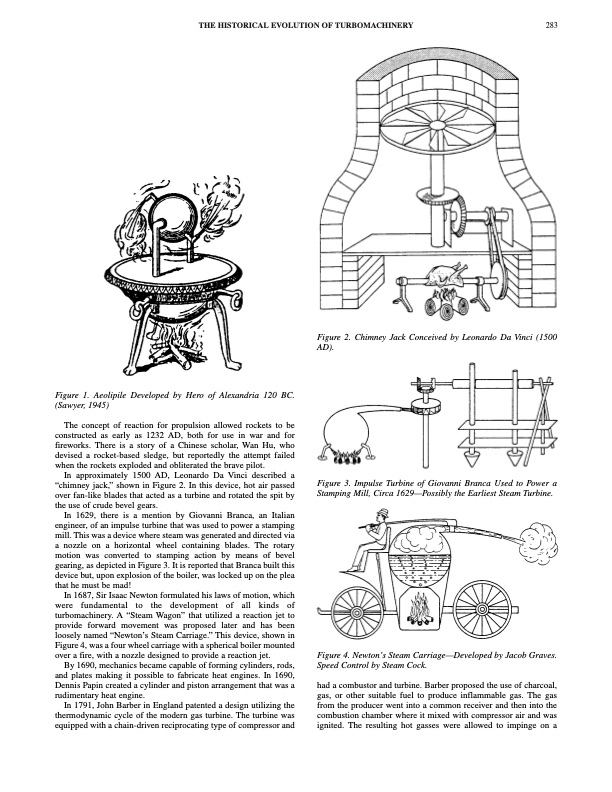
PDF Publication Title:
Text from PDF Page: 003
THE HISTORICAL EVOLUTION OF TURBOMACHINERY 283 Figure 2. Chimney Jack Conceived by Leonardo Da Vinci (1500 AD). Figure 1. Aeolipile Developed by Hero of Alexandria 120 BC. (Sawyer, 1945) The concept of reaction for propulsion allowed rockets to be constructed as early as 1232 AD, both for use in war and for fireworks. There is a story of a Chinese scholar, Wan Hu, who devised a rocket-based sledge, but reportedly the attempt failed when the rockets exploded and obliterated the brave pilot. In approximately 1500 AD, Leonardo Da Vinci described a “chimney jack,” shown in Figure 2. In this device, hot air passed over fan-like blades that acted as a turbine and rotated the spit by the use of crude bevel gears. In 1629, there is a mention by Giovanni Branca, an Italian engineer, of an impulse turbine that was used to power a stamping mill. This was a device where steam was generated and directed via a nozzle on a horizontal wheel containing blades. The rotary motion was converted to stamping action by means of bevel gearing, as depicted in Figure 3. It is reported that Branca built this device but, upon explosion of the boiler, was locked up on the plea that he must be mad! In 1687, Sir Isaac Newton formulated his laws of motion, which were fundamental to the development of all kinds of turbomachinery. A “Steam Wagon” that utilized a reaction jet to provide forward movement was proposed later and has been loosely named “Newton’s Steam Carriage.” This device, shown in Figure 4, was a four wheel carriage with a spherical boiler mounted over a fire, with a nozzle designed to provide a reaction jet. By 1690, mechanics became capable of forming cylinders, rods, and plates making it possible to fabricate heat engines. In 1690, Dennis Papin created a cylinder and piston arrangement that was a rudimentary heat engine. In 1791, John Barber in England patented a design utilizing the thermodynamic cycle of the modern gas turbine. The turbine was equipped with a chain-driven reciprocating type of compressor and Figure 3. Impulse Turbine of Giovanni Branca Used to Power a Stamping Mill, Circa 1629—Possibly the Earliest Steam Turbine. Figure 4. Newton’s Steam Carriage—Developed by Jacob Graves. Speed Control by Steam Cock. had a combustor and turbine. Barber proposed the use of charcoal, gas, or other suitable fuel to produce inflammable gas. The gas from the producer went into a common receiver and then into the combustion chamber where it mixed with compressor air and was ignited. The resulting hot gasses were allowed to impinge on aPDF Image | THE HISTORICAL EVOLUTION OF TURBOMACHINERY

PDF Search Title:
THE HISTORICAL EVOLUTION OF TURBOMACHINERYOriginal File Name Searched:
t29pg281.pdfDIY PDF Search: Google It | Yahoo | Bing
NFT (Non Fungible Token): Buy our tech, design, development or system NFT and become part of our tech NFT network... More Info
IT XR Project Redstone NFT Available for Sale: NFT for high tech turbine design with one part 3D printed counter-rotating energy turbine. Be part of the future with this NFT. Can be bought and sold but only one design NFT exists. Royalties go to the developer (Infinity) to keep enhancing design and applications... More Info
Infinity Turbine IT XR Project Redstone Design: NFT for sale... NFT for high tech turbine design with one part 3D printed counter-rotating energy turbine. Includes all rights to this turbine design, including license for Fluid Handling Block I and II for the turbine assembly and housing. The NFT includes the blueprints (cad/cam), revenue streams, and all future development of the IT XR Project Redstone... More Info
Infinity Turbine ROT Radial Outflow Turbine 24 Design and Worldwide Rights: NFT for sale... NFT for the ROT 24 energy turbine. Be part of the future with this NFT. This design can be bought and sold but only one design NFT exists. You may manufacture the unit, or get the revenues from its sale from Infinity Turbine. Royalties go to the developer (Infinity) to keep enhancing design and applications... More Info
Infinity Supercritical CO2 10 Liter Extractor Design and Worldwide Rights: The Infinity Supercritical 10L CO2 extractor is for botanical oil extraction, which is rich in terpenes and can produce shelf ready full spectrum oil. With over 5 years of development, this industry leader mature extractor machine has been sold since 2015 and is part of many profitable businesses. The process can also be used for electrowinning, e-waste recycling, and lithium battery recycling, gold mining electronic wastes, precious metals. CO2 can also be used in a reverse fuel cell with nafion to make a gas-to-liquids fuel, such as methanol, ethanol and butanol or ethylene. Supercritical CO2 has also been used for treating nafion to make it more effective catalyst. This NFT is for the purchase of worldwide rights which includes the design. More Info
NFT (Non Fungible Token): Buy our tech, design, development or system NFT and become part of our tech NFT network... More Info
Infinity Turbine Products: Special for this month, any plans are $10,000 for complete Cad/Cam blueprints. License is for one build. Try before you buy a production license. May pay by Bitcoin or other Crypto. Products Page... More Info
| CONTACT TEL: 608-238-6001 Email: greg@infinityturbine.com | RSS | AMP |